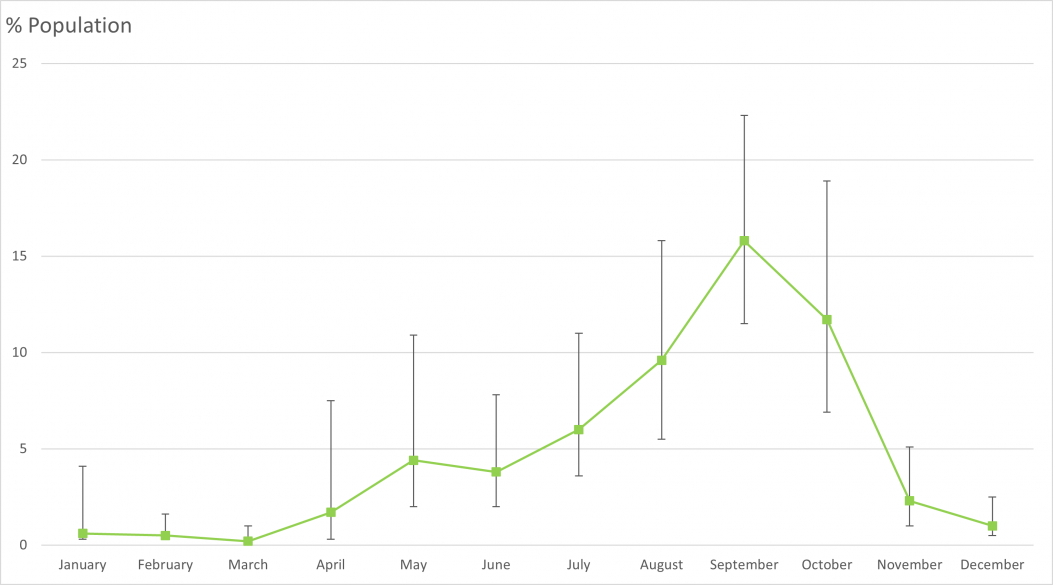Vitamin D deficiency
This section presents statistics on vitamin D deficiency in Aotearoa New Zealand.
On this page:
The importance of vitamin D
Vitamin D is a group of vitamins. The primary form, Vit D3, is produced from cholesterol when Beta rays of UV light (UVB) penetrate the skin. Vitamins D2 and D3 can be found in small amounts in a range of foods such as oily fish, mushrooms and Vit D fortified dairy and cereal products. There are also many supplements that can be useful for at-risk groups.
Low vitamin D levels affect bone and muscle health, leading to osteoporosis and osteomalacia in adults and rickets in children. Vitamin D deficiency is also being investigated for its effects on:
- Pregnancy: Links have been made between deficiency and gestational diabetes, low birth weights, and preterm deliveries. For more information, visit the Ministry of Health website.
- Diabetes: Deficiency during pregnancy and infancy has been linked to increased rates of type 1 diabetes in children.
- Immune Health: Vitamin D is believed to assist in regulating the immune system.
- Cardiovascular Disease: Observational research suggests that Vitamin D deficiency can increase the risk of cardiovascular disease [1].
One in twenty adults have vitamin D deficiency
According to the 2008/09 New Zealand Adult nutrition survey [2]:
- 4.9 percent of adults were vitamin D deficient, including 0.2 percent of adults who had severe deficiency
- A further 27.1 percent were below the recommended levels of vitamin D.
The following groups had higher levels of vitamin D deficiency:
- pacific adults (2.3 times more likely than non-Pacific adults)
- people who lived in the most socioeconomically deprived areas (NZDep2006 quintile 5)
- obese individuals had lower mean vitamin D levels
Risk factors for vitamin D deficiency
- Having naturally darker skin, which affects Māori and Pacific Peoples, as well as people from Africa, the Indian subcontinent and the Middle East.
- Lacking regular sun exposure.
- Living in the South Island, with the risk increasing the further south you live.
- Certain liver and kidney diseases and medications can also affect vitamin D levels.
People are more at risk in winter and the South Island
During late winter and early spring (August to October), vitamin D deficiency is over three times greater in Southern New Zealand compared to Northern New Zealand [3]. As seen in Figure 1, vitamin D deficiency is most common at the beginning of spring.
During winter (June to August), the UVI will only be greater than 0 for certain periods of the day [3]:
- in Auckland this is between roughly 9 am and 4 pm
- in Central Otago this is between roughly 10 am and 3 pm.
Outside of these times, the body produces very little or no vitamin D, leading to the risk of deficiency.
Figure 1: Prevalence of vitamin D deficiency by month in adults 15 years and over in New Zealand.

Source: 2008/09 New Zealand Adult nutrition survey [2]
Information about the data
Prevalence of Vitamin D deficiency
Source: Vitamin D Status of New Zealand Adults [1]. Data come from the 2008/09 New Zealand Adult Nutrition Survey. Vitamin D deficiency was based on blood samples collected as part of the survey.
Definition: Proportion of the adult population (aged 15+ years) who have vitamin D deficiency. This is defined as a serum 25-OHD level less than 25.0 nmol/L. Severe deficiency was defined as a serum 25-OHD level less than 12.5 nmol/L. The Ministry of Health recommends that individuals have an annual mean vitamin D (serum 25-OHD) level of 50.0 nmol/L or greater.
